Giant Salamander
Cryptobranchus giant salamanders breathe mostly through their skin.
Advertisement
Giant Salamander Scientific Classification
Read our Complete Guide to Classification of Animals.
Giant Salamander Conservation Status
Giant Salamander Facts
- Prey
- Aquatic life, including crabs, fish, frogs and giant salamanders
- Name Of Young
- Larvae
- Group Behavior
- Solitary
- Fun Fact
- Cryptobranchus giant salamanders breathe mostly through their skin.
- Estimated Population Size
- The South China giant salamander may be extinct, and there are less than 50,000 Chinese giant salamanders and 590 Ozark hellbenders left in the wild. Biologists aren't quite sure how many Japanese giant salamanders are left in the wild though its conservation status is near threatened. There are about 13,000 Pacific giant salamanders in British Columbia.
- Biggest Threat
- Pollution, habitat destruction, over-harvesting
- Most Distinctive Feature
- Their size
- Other Name(s)
- Hellbenders are called hellbender salamander, devil dog, water dog, mud dog, grampus, mud devil, Allegheny alligator and leverian water newt. Chinese giant salamanders are called infant fish because they make a noise like a baby’s cry. The Japanese giant salamander is called the giant pepper fish, or Ōsanshōuo because of the smell it gives off.
- Gestation Period
- 40 to 210 days before eggs hatch
- Litter Size
- 83 to 600 eggs
- Diet
- Omnivore
- Type
- Amphibian
- Common Name
- Giant salamander, hellbender, Japanese giant salamander, Chinese giant salamander, South China giant salamander, Pacific giant salamander
- Location
- East Asia, eastern United States, Canada
- Group
- Solitary
View all of the Giant Salamander images!
Though the sight or even the thought of a nearly six-foot-long salamander may be off-putting to some people, giant salamanders play a vital role in their ecosystems.
The Chinese and Japanese giant salamanders are apex predators and keep the populations of other aquatic animals in balance. The health of the much smaller hellbender and Pacific giant salamander shows humans whether the water they live in is healthy. Still, populations of giant salamander are under pressure due to pollution and habitat destruction. Not only this, many people aren’t so put off by a giant salamander that they won’t eat them in great numbers. This is why the Chinese giant salamander, the world’s largest amphibian, is critically endangered and why the South China giant salamander is possibly extinct in the wild.
5 Incredible Giant Salamander Facts!
- Giant salamanders are cannibalistic.
- Unlike many other kinds of salamanders, at least two species of giant salamanders can vocalize.
- They are ambush predators.
- Cryptobrachus giant salamanders use sensors in their heads to detect changes in water pressure. This leads them to their prey.
- Some people keep hellbenders as a pet, but keeping this amphibian as a pet may be illegal in some places.
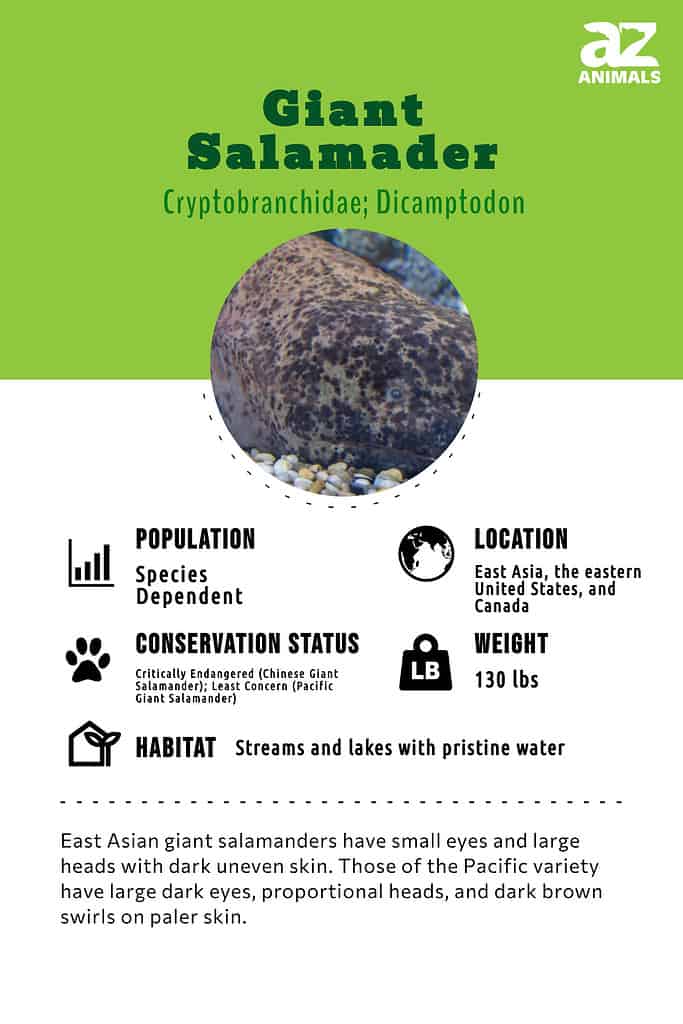
Scientific Name

Giant Salamanders are named according to their locations and belong to three distinct genera
©Michael Benard/Shutterstock.com
Some giant salamanders belong to the Cryptobranchidae family. Cryptobrachus is Greek for “hidden gill” because these salamanders lose their gills when they become adults. There are two genera in the family.
The hellbender belongs to the Cryptobranchus genus, and its scientific name is Cryptobranchus alleganiensis. Alleganiensis means that the animal is of the Allegheny Mountain area of the United States. The hellbender has two subspecies:
- C. a. alleganiensis
- C. a. bishopi
Types
Giant salamanders belonging to the Cryptobranchidae family are by no means the sole variety in existence.
There are other genera such as the Andrias genus. Andrias is Greek for “statue.” Andrias davidianus is the Chinese giant salamander, though some biologists claim this is a catchall name for five species. The epithet is named for Father Jean Pierre Armand David, a French missionary.
Andrias sligoi is the South China giant salamander. It was named for the Marquess of Sligo, George Ulick Browne, in 1924.
Andrias japonica is the Japanese giant salamander. Its Latin epithet japonicus just means that it’s from Japan.
The Pacific giant salamander belongs to the Dicamptodon genus. Dicamptodon is from the Greek and means “having teeth with double curves.” There are four species:
- Dicamptodon aterrimus
- Dicamptodon copei
- Dicamptodon ensatus
- Dicamptodon ensatus
Evolution
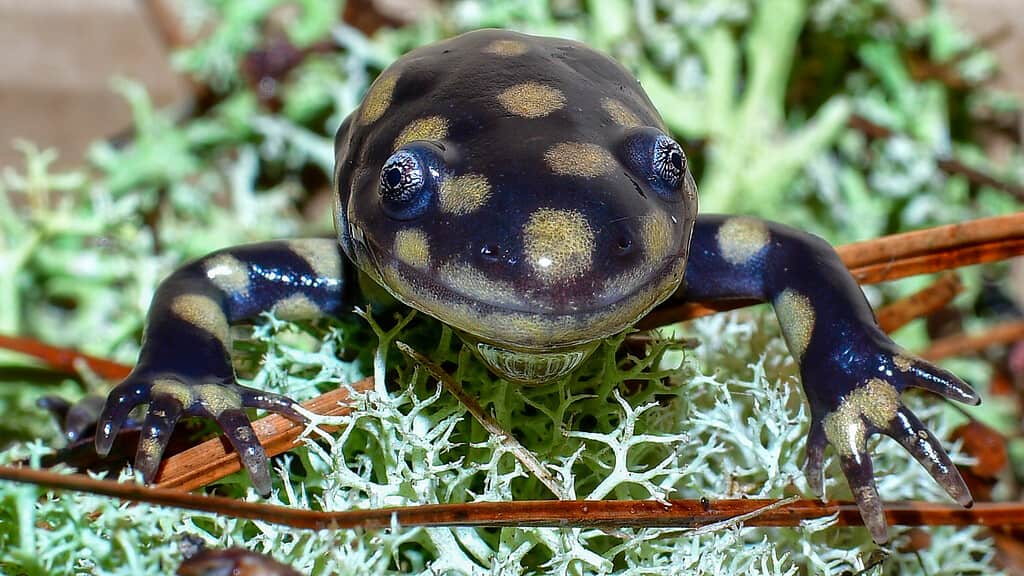
The majority of the ancestors of present day salamanders emerged during the Cretaceous
©Chase D’animulls/Shutterstock.com
To trace the evolutionary pathway of giant salamanders it is necessary to ascend the family tree. Which means going up to the order Urodela, all the way to the clade Caudata.
According to scientists, the ancestors of the group separated from lobe-finned fish about 360 million years ago. Following which the Urodela as well as other now extinct groups appeared.
Several fossils dating back to the Triassic and the Jurassic have been found in Central Asia such as the Kokartus honorarius. The Jurassic itself which occurred between 145 – 201 million years ago also withnessed the emergence of the Cryptobranchoidea, the parent group of Asian Giant salamanders.
The following period, the Cretaceous lasting from 66 – 145 million years ago witnessed the emergence of the majority of the salamander species currently in existence, at present.
Appearance
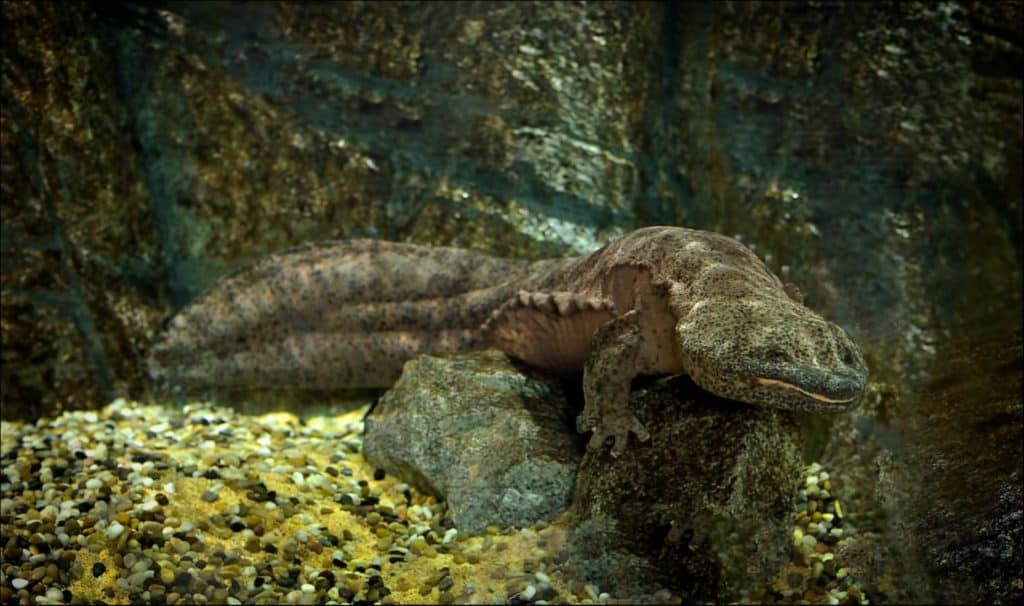
Giant Salamanders can measure up to 110 lbs in weight and 3.8 feet in length
©tristan tan/Shutterstock.com
The hellbender is between 1.0 and about 2.5 feet in length and weighs between 0.90 and 2.2 pounds. It has a flat body with frills of loose skin on its sides that help the animal pull oxygen from the water. The hellbender’s head is also flat, and it has tiny eyes with no eyelids. It has five webbed toes on its back feet and four webbed toes on its front feet. Its legs are short and stubby, but the tail is strong and helps propel the animal through the water. The ground color of the body is black or brown and some specimens have orange spots. The larvae of the hellbender look very much like tadpoles.
The Chinese giant salamander is much bigger than the hellbender at close to 3.8 feet in length, average. It usually weighs between 55 and 66 pounds but can weigh as much as 110 pounds. The largest Chinese giant salamander weighed 130 pounds and was 5.9 feet long. Its skin is dark, mottled, loose, and wrinkled, and it has lidless eyes and a large, flat head. There are tubercles around its throat and head.
The Japanese giant salamander isn’t as large as the Chinese giant salamander but can grow to 5 feet in length and weigh around 55 pounds. Its body can be brown, yellowish or reddish-brown, or black, with splotches that help camouflage it.
The South China giant salamander is even larger than the Chinese giant salamander. It can grow to nearly 6.56 feet long. Like the other salamanders, it has a flat head and loose frills of skin on the sides of its body to help it breathe. Its overall coloring is mottled gray.
The Pacific giant salamander can grow to about 13.39 inches long and weigh up to 4 ounces. Its body is dark brown and spotted or marbled, and its belly is white. Unlike the Cryptobranchus species, it has bulging eyes and freckled irises. Its legs are strong, and its toes are not webbed. Males have longer tails than females.
Behavior
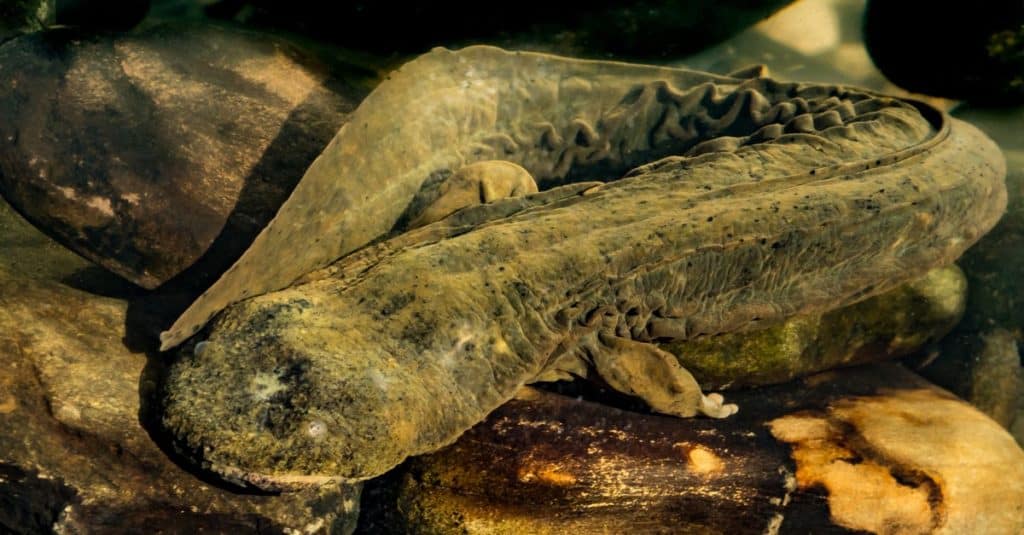
Giant Salamanders have mouths filled with sharp teeth and are very willing to use them
©Jay Ondreicka/Shutterstock.com
Giant salamanders are solitary and will see off other giant salamanders that come into their territory save during their breeding season. During the day they sleep under rocks. All giant salamanders secrete a substance that deters would-be predators, and in the case of the Japanese giant salamander, the secretion has a smell like the Japanese pepper plant.
Since Cryptobrachus salamanders have tiny, lidless eyes, they mostly use smell and touch to get around. The Chinese giant salamander is notorious for its vocalizations, which not only include hisses, whistles, and barks but a noise that sounds very much like the cry of a human baby. The Pacific giant salamander barks like a dog. Both the Japanese giant salamander and the hellbender have a lateral line along their bodies to detect light, vibrations, and water pressure.
Giant salamanders have lots of tiny teeth, and they can and do bite. A Japanese salamander’s jaws are strong enough to take off part of a human finger. Pacific giant salamanders also won’t hesitate to bite a would-be predator.
Habitat

Certain Giant Salamander subspecies require clear, clean water filled with oxygen
©Martin Voeller/Shutterstock.com
Because they have to work rather hard to breathe through their skin, Cryptobrachus giant salamanders prefer clear, clean cool water that can hold on to a lot of oxygen. The Japanese salamander is only found in Japan and lives in rivers in the southwestern part of the country. The hellbenders are found in the Appalachian Mountains from New York to northern Alabama, and there’s an isolated population of hellbenders in Missouri.
The Chinese giant salamander, which may comprise five clades, is found in south, southwestern and central China. Some have also been found in Taiwan, but biologists suspect they were introduced there. The South China giant salamander is only found in southern China, mostly in the Pearl River basin.
The Pacific giant salamander is able to live on land but must stay close to wet places to keep its skin from drying out. It’s only found in the Pacific Northwest area of North America.
Diet
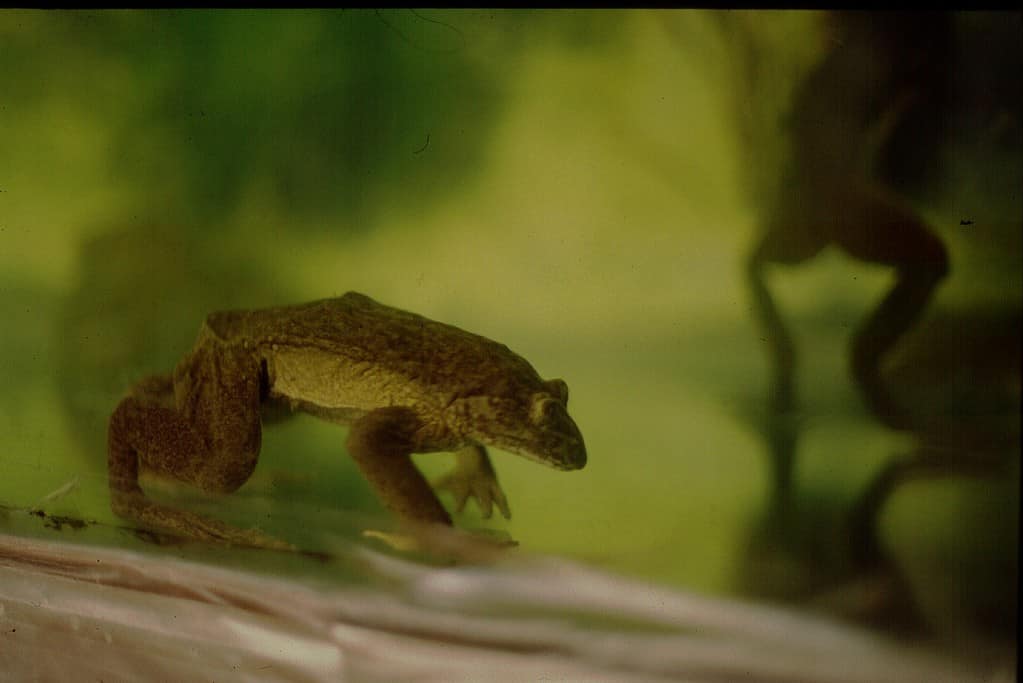
Giant salamanders enjoy a varied diet and are partial to other amphibians, too
©Carlos Arias Segura / CC BY-SA 4.0 – License
The Japanese and Chinese giant salamanders eat insects, other amphibians including each other, fish, crabs, crustaceans, worms, and millipedes. They will also eat small mammals such as the Asiatic water shrew. The hellbender eats the crayfish that shares its habitat as well as small fish, tadpoles, insects, and salamanders that are small enough for it to handle. Because it is a bottom feeder, it will also take in mud and other debris.
Since the Pacific giant salamander can live on land, it will sometimes climb trees for as far as six and a half feet off the ground to find prey.
Predators and Threats

Otters are known to hunt giant salamanders
©iStock.com/Cloudtail_the_Snow_Leopard
Japanese and Chinese giant salamanders are top predators where they live, and nothing eats a grown, sizable individual but a human and another member of their species. Larvae are subject to predation by fish and adult members of their species. The much smaller hellbenders are also eaten by large fish and by members of their own species. People do not eat hellbenders, but sometimes they are by-catch of fishermen. Pacific giant salamanders are eaten by mustelids, snakes, and fish such as salmon.
Hellbenders are also subject to parasites such as tapeworms, leeches, and nematodes. If they are healthy, they can fight off disorders brought by these parasites. Polluted waters weaken the giant salamander’s immune system and make it harder to fight parasites and diseases. Chinese giant salamanders are overhunted, and most of the other Cryptobrachus salamanders are endangered due to habitat destruction.
What Eats the Giant Salamander?
Giant salamander larvae are eaten by fish and other salamanders. Adult Chinese giant salamanders are eaten by people and other Chinese giant salamanders. Hellbenders can be taken by fish, and Pacific giant salamanders are on the menu for water shrews, snakes, fish, river otters, and weasels.
What Does the Giant Salamander eat?
Giant salamanders eat other amphibians, worms, crayfish, fish, insects, other aquatic invertebrates, and occasionally aquatic mammals such as water shrews.
Reproduction and Life Cycle
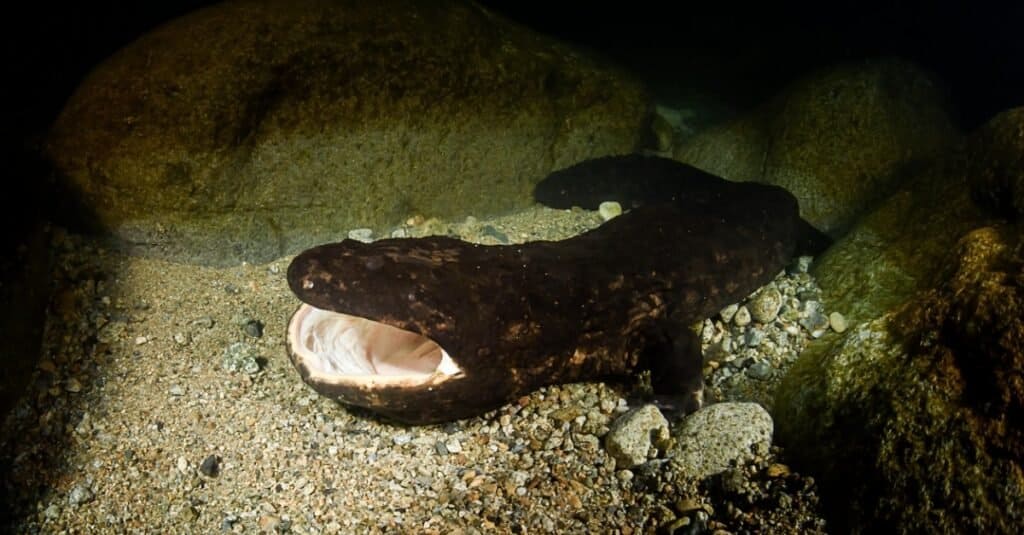
Japanese giant salamanders breed in autumn and the male guards the eggs until they hatch about 3 or 4 months later
©iStock.com/Martin Voeller
The male Cryptobrachus salamander guards the eggs and sometimes the larvae. He may eat some of the eggs, but these eggs are usually defective.
Japanese giant salamanders’ breeding season is in the fall. By the end of August, they swim to spawning pits, which are just hollows in the bottom of the stream or rock-lined crevices or burrows. Males fight over the best spawning pits and can hold on to one for decades. Then, females arrive. After a bit of courting, she’ll lay 400 to 500 eggs in the pit, and the male fertilizes them. The male Japanese giant salamander can fertilize the eggs of more than one female, and he will guard all the eggs until they hatch after about 12 to 15 weeks.
The breeding season for the hellbender is from late summer to early autumn, and the female lays between 150 to 450 eggs in his pit. The eggs hatch between 45 and 80 days.
The Chinese giant salamander breeds in late summer, when the water temperature is at least 68 degrees Fahrenheit. The female deposits between 400 and 500 eggs in the male’s spawning pit and her eggs hatch 50 to 60 days after they’ve been fertilized.
The Pacific giant salamander breeds beginning in spring and ending in fall, and females swim upstream to lay their eggs. In the case of this salamander, the female guards her eggs and may do so for as long as seven months. It takes about five to six years for a Pacific giant salamander to grow large enough to breed.
Chinese giant tadpole larvae lose their gills when they’re about three years old. They reach adulthood when they are five to six years old and can have a lifespan of 60 years or longer.
No one knows when Japanese giant salamanders reach sexual maturity, but it’s assumed they have to be of a decent size. They can have a lifespan of over 50 years.
Hellbenders become mature when they’re between five and eight years old and can live more than 30 years.
Pacific giant salamanders probably become mature when they’re five or six. Biologists aren’t sure how long they live.
Population

Chinese giant salamanders are critically endangered with a population of about 50,000
©Danny Ye/Shutterstock.com
Though no one knows exactly how many Japanese giant salamanders live in the wild, the species is considered near threatened. There are about 50,000 Chinese giant salamanders, but it is critically endangered, as is the South Chinese giant salamander. Indeed, this salamander may be already extinct. The hellbender, of which there are only 590 left in the Ozarks, is near threatened. There are about 30,000 Pacific giant salamanders in British Columbia, and their conservation status is least concern.
View all 170 animals that start with GGiant Salamander FAQs (Frequently Asked Questions)
Do giant salamanders bite?
Yes, giant salamanders do bite, but they are not aggressive towards humans and may take a bite out of a hand that’s trying to pet them because they mistake it for food.
What do giant salamanders eat?
Giant salamanders eat insects, shrimp, fish, worms, millipedes, tadpoles, smaller salamanders and frogs, small aquatic mammals and each other.
What is the largest salamander called?
The largest salamander in the world is the South Chinese salamander, which can grow to 6.5 feet long.
How many giant salamanders are left in the world?
According to scientists, there may be only tens of thousands of giant salamanders left in the wild, though millions of Chinese giant salamanders are bred for their meat.
Thank you for reading! Have some feedback for us? Contact the AZ Animals editorial team.
Sources
- Wikipedia, Available here: https://en.wikipedia.org/wiki/Chinese_giant_salamander
- US Fish & Wildlife Service, Available here: https://www.fws.gov/midwest/endangered/amphibians/ozhe/ozheSummary2011FinalRule.html
- Macro Evolution, Available here: http://www.macroevolution.net/chinese-giant-salamander.html
- Animal Diversity Web, Available here: https://animaldiversity.org/accounts/Andrias_japonicus/
- New Scientist, Available here: https://www.newscientist.com/article/2216451-new-species-of-giant-salamander-is-the-worlds-largest-amphibian/
- National Geographic, Available here: https://www.nationalgeographic.com/animals/article/giant-salamander-new-species-worlds-largest-amphibian
- Smithsonian National Zoo, Available here: https://nationalzoo.si.edu/animals/japanese-giant-salamander

















